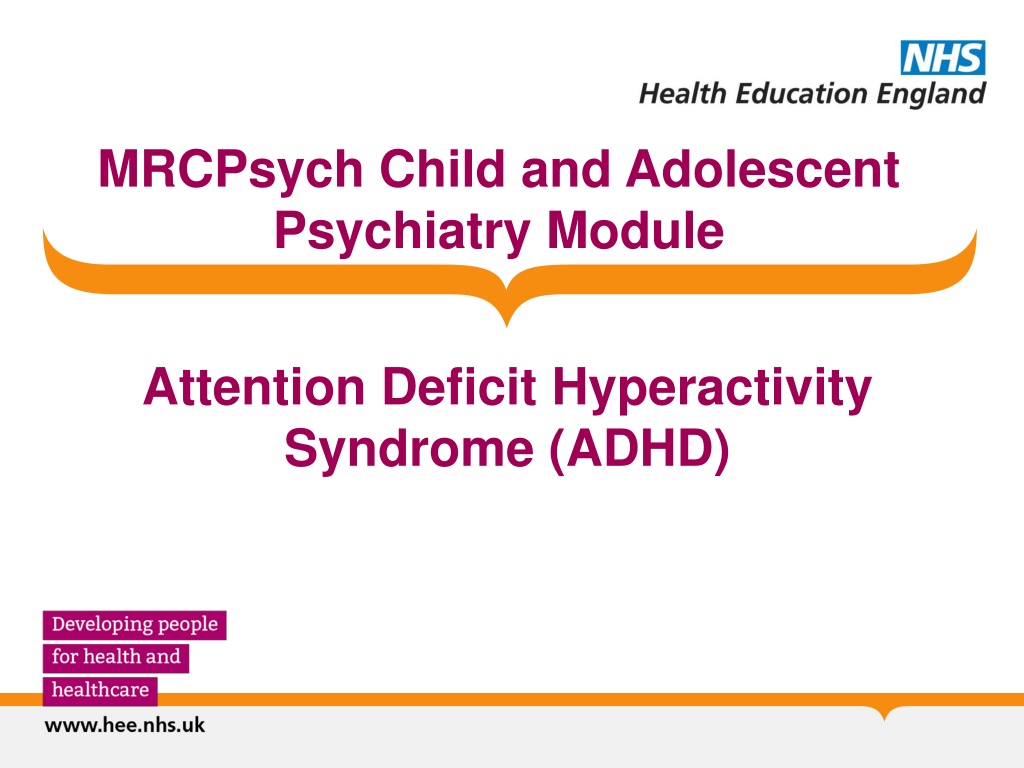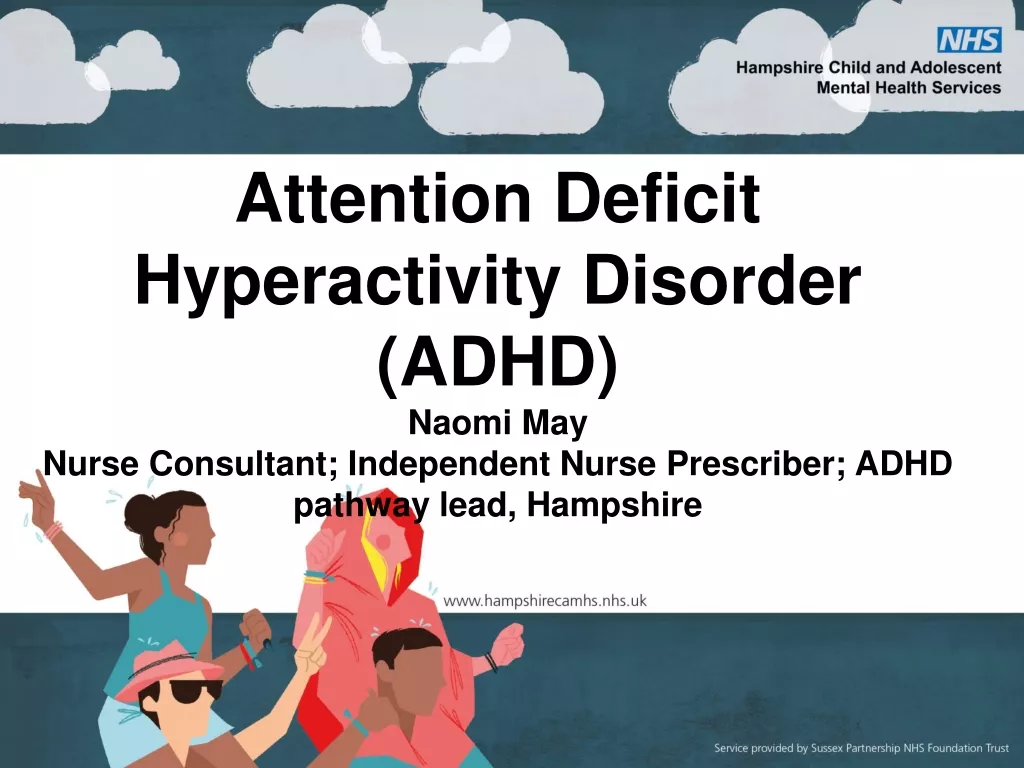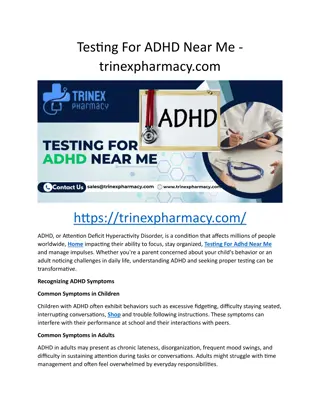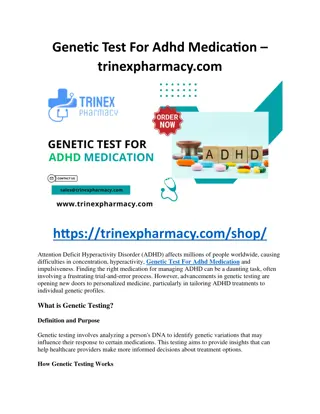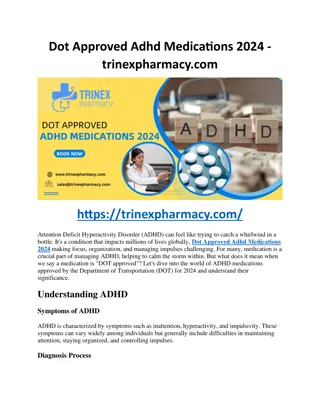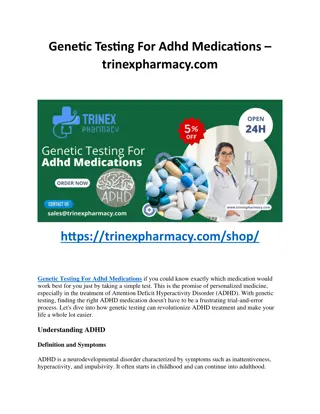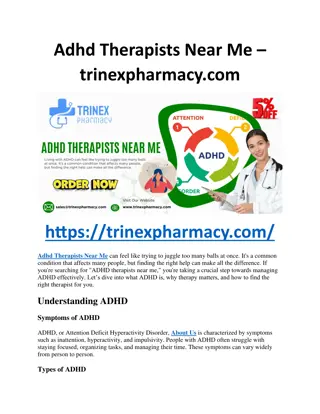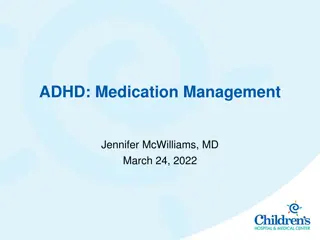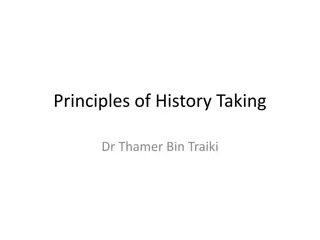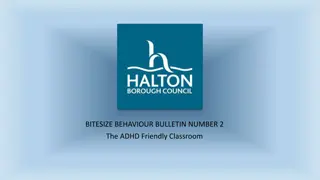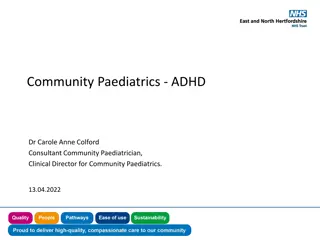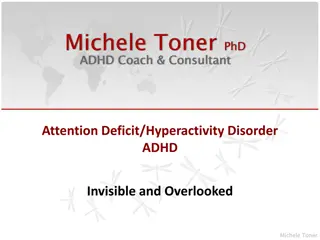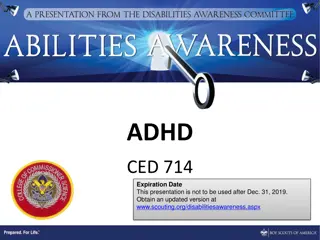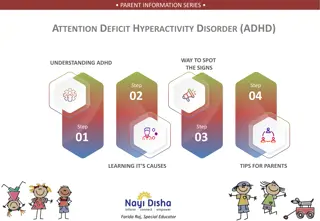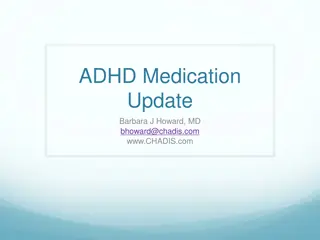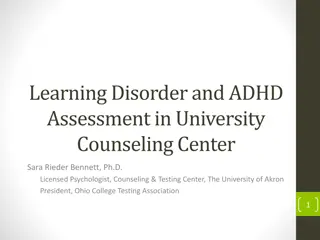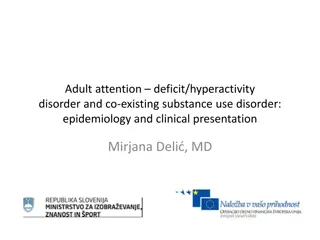ADHD: History, Assessment, and Treatment Insights
Explore the historical origins of ADHD, the clinical features, prevalence, and treatment options. Gain insights into the assessment process, co-morbidities, and the impact of non-treatment on substance misuse. Learn about key milestones in ADHD recognition, from early descriptions by physicians to modern diagnostic criteria.
Download Presentation

Please find below an Image/Link to download the presentation.
The content on the website is provided AS IS for your information and personal use only. It may not be sold, licensed, or shared on other websites without obtaining consent from the author.If you encounter any issues during the download, it is possible that the publisher has removed the file from their server.
You are allowed to download the files provided on this website for personal or commercial use, subject to the condition that they are used lawfully. All files are the property of their respective owners.
The content on the website is provided AS IS for your information and personal use only. It may not be sold, licensed, or shared on other websites without obtaining consent from the author.
E N D
Presentation Transcript
MRCPsych Child and Adolescent Psychiatry Module Attention Deficit Hyperactivity Syndrome (ADHD)
CAMHS Module: ADHD Aims and Objectives The overall aim is for the trainee to gain an overview of ADHD By the end of the session trainees should: Describe signs, symptoms and differential diagnosis of Attention Deficit Hyperactivity Disorder, and treatment options
CAMHS Module: ADHD To achieve this Case Presentation Journal Club 555 Presentation Expert-Led Session MCQs Please sign the register and complete the feedback
CAMHS Module: ADHD Consider aspects of assessment, formulation, evidence base, NICE guidelines of assessment and intervention, differential diagnosis, co-morbidities, consequences of non-treatment and impact on substance misuse.
ADHD History Definition ICD10 & DSM V Prevalence Clinical features Differential diagnosis Co-morbidities Aetiology Treatment Prognosis: consequence of non treatment & impact on substance misuse
History of ADHD Not a new concept 1865 Heinrich Hoffman, German Physician described Fidgety Philip won t sit still, wriggles, giggles, swings backwards, tilts his chair growing rude and wild 1902: George Still 3 lectures to the Royal College of Physicians, described 43 impulsive children with significant behaviour problems often aggressive, defiant, resistant to discipline 1908: Tredgold also described similar children who would now have a diagnosis of ADHD with Oppositional Defiant Disorder or Conduct Disorder
History of ADHD 1917-18 Encephalitis epidemic in North America Sequelae similar to concept of ADHD 1937 Charles Bradley Amphetamine in children with EBD improvement in over-activity & classroom behaviour 1940 Methylphenidate (Ritalin) synthesised 1991-1995 USA500% increased in production. Has continued to increase 1996-2006 UK - 50,000 -500,000 prescriptions. 1990s Adult ADHD
ADHD Clearly defined clinical condition Common Tends to run in Families probably results from a combination of factors Children with ADHD have other problems
Diagnostic classification ICD 10: Hyperkinetic Disorder a persistent and severe impairment of psychological development, characterised by a combination of overactive, poorly modulated behaviour with marked inattention and lack of persistent task involvement; and pervasiveness, over situations and persistence over time of these behavioural characteristics
Dignostic Classification DSM V: ADHD ADHD is described as a persistent pattern of inattention and/or hyperactivity-impulsivity that interferes with development, has symptoms presenting in two or more settings (e.g. at home, school, or work), and negatively impacts directly on social, academic or occupational functioning - symptoms present before age 12
ICD 10: F90 Behavioural and emotional disorders with onset usually occurring in childhood and adolescence F90 Hyperkinetic disorder F90.0 Disturbance of activity and attention F90.1 Hyperkinetic conduct disorder F90.8 Other hyperkinetic disorders F90.9 Hyperkinetic disorder, Age specific
ICD 10 medical classification system for HKD Simultaneous hyperactivity, impulsivity and inattentiveness Symptoms prior to 6 years of age Impairment present in 2 settings Exclude diagnosis of mania, depression, anxiety disorders and/or pervasive developmental disorder
ICD 10 medical classification system for HKD Describes that the characteristic behaviour problems associated with HKD should be of early onset (age <6 years) and of long duration Caution is recommended in children of pre-school age and only extreme levels of hyperactivity should lead to a diagnosis in these individuals Diagnosis of HKD may also be made in adult life using the same criteria, however, attention and activity must be judged with reference to developmentally appropriate norms
DSM V medical classification system for ADHD Children 6 symptoms of inattention and/or 6 symptoms of hyperactivity- impulsivity, for 6 months prior to assessment Adults 5 symptoms of inattention and/or 5 symptoms of hyperactivity- impulsivity, for 6 months prior to assessment Hyperactive-impulsive or inattentive symptoms prior to 12 years of age Impairment present in 2 settings Clinically significant impairment in social, academic or occupational environments Symptoms do not occur exclusively during the course of schizophrenia or another psychotic disorder, or are not better accounted for by another mental disorder
Attention Deficit Hyperactivity Disorder Inattention Impulsivity Hyperactivity Executive Functions
Inattention But there are at least 6 types of attention Arousal, alertness, selective, divided, span of attention, & persistence Not all are impaired - What is? Poor persistence toward goals or tasks Impaired resistance to responding to distractions Deficient task re-engagement following disruptions Impaired working memory (remembering so as to do) in 80% of children with ADHD
Hyperactivity and Impulsivity Often fidgets with or taps hands or feet, or squirms in seat. Often leaves seat in situations when remaining seated is expected. Often runs about or climbs in situations where it is not appropriate (adolescents or adults may be limited to feeling restless). Often unable to play or take part in leisure activities quietly. Is often "on the go" acting as if "driven by a motor". Often talks excessively. Often blurts out an answer before a question has been completed. Often has trouble waiting his/her turn. Often interrupts or intrudes on others (e.g., butts into conversations or games)
Executive Functioning ADHD disrupts the 5 levels EF but especially the tactical and strategic levels thereby creating a disorder of self- regulation across time ADHD can be considered as Time Blindness or a Temporal Neglect Syndrome (Myopia to the Future) It adversely affects the capacity to hierarchically organize behavior across time to anticipate the future and to pursue one s long-term goals and self-interests (welfare and happiness) It s not an Attention Deficit but an Intention Deficit (Inattention to mental events & the future) (From Professor Russell Barkley)
PLUS the following conditions must be met Several inattentive or hyperactive-impulsive symptoms were present before age 12 years Several symptoms are present in two or more settings: home, school or work; with friends or relatives; in other activities There is clear evidence that the symptoms interfere with, or reduce the quality of, social, school, or work functioning The symptoms do not happen only during the course of schizophrenia or another psychotic disorder. The symptoms are not better explained by another mental disorder e.g. Mood Disorder, Anxiety Disorder, Dissociative Disorder, or a Personality Disorder
ADHD Prevalence 3-5% of UK children have ADHD Gender ratio: M: F 4:1 Mental Health clinics 6:1 9:1 Many girls do not get diagnosed Predominantly inattentive and diagnostic construct based in male behaviour Hyperkinetic Disorder UK: 1% of school aged children, UK ~69,000 6-16 yrs olds in England (NICE) 4,200 in Wales (NICE) LAC: 9% (BMJ 2007)
Co-morbidity Over 50% will have one or more of the following conditions. Learning disabilities 20-30% have ADHD but can also mimic ADHD in situations Tic & Tourette s Syndrome 7% have Tic disorder 60% TS have ADHD Oppositional Defiant Disorder (ODD) 1/3 of ADHD children mainly boys have ODD Conduct Disorder (CD) 20-40% of ADHD children have CD ASD 1/3 have ADHD Anxiety 34% Depression, Substance abuse, Developmental language delay
ADHD in girls Easily distracted Disorganized and messy Friendship troubles Forgetful/day dreamy Difficulty completing tasks Slow to process information and directions (It may even appear that they aren t hearing you) Careless Often late (poor time management) Hyper-talkative Verbally impulsive (blurts out, interrupts others) Easily upset, over-reactive
Differential diagnosis Disinhibited attachment disorder; Over-activity associated with autistic spectrum disorders including Asperger's syndrome Conduct disorder Anxious in-attentiveness secondary to stress and trauma Agitated depression; past closed head injury Attention deficit without over-activity Gilles de la Tourette syndrome Chromosomal disorders e.g. Fragile X syndrome Lack of consistent parenting Specific learning difficulties Physical or sexual abuse or neglect
What causes ADHD? Exact causes unknown Substantial evidence: Neurobiology and Genetics Very little evidence for purely social factors or child-rearing methods Environment can play a part to influence severity of ADHD but it is not the cause
What causes ADHD? Neurobiology Reduced Dopamine and Noradrenaline in the synaptic cleft this is thought to be due to: faster reuptake of NA/DA, not enough is produced Medication for ADHD reduces the re-uptake of DA and NA back in to the neurones
What causes ADHD? Environmental agents Some studies have shown association between: use of Cocaine, Benzodiazepine abuse, Alcohol and Cigarettes in pregnancy and risk of ADHD in the child Low birth weight Higher levels of lead in children with ADHD Prenatal stress Pesticides
What causes ADHD? Brain Injury Only a small percentage of children with ADHD have suffered a traumatic brain injury
What causes ADHD Food additives and Sugar 1982 scientific consensus about 5% of children with ADHD had food allergies, mostly young children 1985 & 1994 studies no evidence 1985: alternate days of sugar /sugar substitute. Parents/staff/children did not know 1994: Given sugar substitute (Aspartame). 50 % told they were given sugar and other half told given Aspartame. Parents who thought children had sugar rated more hyperactivity and more critical
What causes ADHD? Genetics Often run in families Studies have shown 25% close relatives in the families of ADHD children have ADHD compared to 5% in the general population 1/3 of ADHD children have at least one parent who has ADHD Twin studies:75% concordance in identical twins ADHD molecular Genetics Network established in 1999 to help researchers to share the findings
Possible causes Epilepsy and other brain disorders (minority) & Low birth weight/prematurity Major disruptions of attachments Excessive drinking and smoking in pregnancy Prenatal exposure to benzodiazepines and anticonvulsants also predict later hyperactive behaviour Exposure to lead in utero and childhood. 9/28/2024
What causes ADHD? Recent Evidence These are imaging studies of the brain 2002: studied 152 (boys and girls) with ADHD vs. 139 age and gender matched controls: ADHD children showed 3-4 % smaller brain volumes in all regions The ones on medication: white matter was similar to normal The ones who never had medication: had smaller white matter
Summary No evidence exists to suggest that ADHD is caused by anything other than neurobiological malfunctioning including deficits in dopamine-decarboxylase in the anterior frontal cortex, leading to reduced dopamine availability and diminished focusing and attention; more symmetrical brains; smaller-sized brains in the area of the prefrontal cortex (caudate, globus pallidus); duplication polymorphism in the DRD4 and DAT genes ADHD sufferers have difficulty in suppressing impulse respond to all impulses, being unable to exclude those that are unnecessary for the situation rather than failing to pay attention, they pay more attention to more cues than the average person, and are unable to stop the relentless flow of information fail to pause, to consider the situation, options and consequences - act without thinking
ADHD across life span Children do not grow out of it 70-80% carry the condition into their adult life Early identification and multi-modal treatment reduces the risk of developing future difficulties including Antisocial behaviour Abuse of alcohol & Tobacco & illicit substance Poor academic & social functioning Poor self esteem Other psychiatric difficulties Pressure on families
Assessment and Diagnosis Assessment and diagnosis by CAMHS/Community Paediatrics Assessment Information from parents/carers and other professionals who know the child (school teachers etc.) Observations in clinic and at school QbTest Rule out other causes for the behaviour Diagnosis Inattention, impulsivity, hyperactivity, present before the age 7 and pervasive Regular monitoring as per NICE guidelines Regular audit of practice against NICE Guidelines
ADHD Treatment and Intervention Multi-modal: social, psychological and behavioural intervention child, parents, teachers Behaviour Management Parenting strategies (WS groups, Parent Child Game) Individual work with Children and Families Medication Address co-morbidities Liaison with school and other agencies Central Manchester and Manchester Children s Hospital NHS Trust Central Manchester PCT
Medication Stimulants Short acting Methylphenidate (Ritalin, Equasym), Dexamfetamine. Long acting Matoride/Concerta XL (20/80 12 hrs) Equasym XL 30/70 8 hrs) Medikinet XL (50/50 8 hrs) Elvanse (pro-drug of Dexamfetamine) lasts for 12 hrs Central Manchester and Manchester Children s Hospital NHS Trust Central Manchester PCT
Medication Non-stimulants Atomoxetine noerepinephrine reuptake inhibitor-long acting up to 24 hrs Guanfacine central alpha 2A-adrenergic receptor agonist
Medication Side-effects Reduced appetite Sleep disturbance Tics Headache Nausea & Vomiting Abdominal Pain Emotional Listlessness Increase in suicidal thoughts (Atomoxetine) 9/28/2024
Maintaining factors Response of parents Response of teachers Peer influences 9/28/2024
NICE guidelines for ADHD Methylphenidate (MTP) is recommended as part of a comprehensive treatment programme not licensed for children <6 Assessment and treatment by Child Psychiatrists or Paediatricians with special expertise in ADHD Should involve children, parents, carers, school, Consider cultural factors and environmental factors Comprehensive treatment programme desirable Regular monitoring and drug holidays Central Manchester and Manchester Children s Hospital NHS Trust Central Manchester PCT
Challenges for Health Services Raising Awareness and training of front line professionals who can refer or direct referrals to CAMHS resource implications Desire to treat Children with ADHD and impairment vs. how can we manage if all these children are referred? Need for multiagency integrated pathways) Multi-modal therapies are the treatment of choice This needs skilled practitioners and closer working relationship with other children services colleagues Implications for ADHD graduates from CAMHS to adulthood Addressing myths about ADHD/Treatments Central Manchester and Manchester Children s Hospital NHS Trust Central Manchester PCT
Prognosis Children with ADHD do not grow out of it Between 70-80% carry the condition into their adult life to a varying degree (Klein and Mannuzza, 1991) Early identification and multimodal treatment reduces the risk of developing further complications Antisocial behaviour Abuse of alcohol, tobacco and illicit substances Poor academic and social functioning, Further psychiatric morbidity
How important is it to treat? Barkley et al 2002 (Milwaukee) identified that adults with ADHD compared to a control group have: 2.4 times the rate of heart disease 11.4% higher BMI 2.2 times the rate of non-medical drug use 32% more medical/dental problems 2.5 times the rate of sleep problems
How important is it to treat? Barkley et al 2002 (Milwaukee) note that adults with ADHD have: increased use of the healthcare system increased use of sick days from employment higher rates of depression, anxiety and antisocial personality disorder higher risk sexual activity higher rates of divorce and separation
How important is it to treat? Barkley et al 2002 (Milwaukee) notes that adults with ADHD have: more job terminations, disciplinary actions, job changes, lower incomes and more problems following instructions and carrying a workload they have significant problems budgeting they have greater rates of driving accidents
MCQ:1 A four year old boy is brought to clinic with his parents. They report that he is inattentive at school, will not sit and play with his siblings at home and on one occasion let go of his mother s hand whilst shopping and ran out into the road. Following assessment and diagnosis, what would your initial management step be? a) Refer patient for individualised CBT b) Refer family for Family Therapy c) Refer family to parent training and education sessions d) Commence 5mg methylphenidate daily, titrating up weekly until improvement is seen e) None of the above
Answer Answer: c: refer to parent training and education sessions. NICE guidelines advise that first steps in management of pre-school aged children with a diagnosis of ADHD should be a referral for parent training and education. Medication is not first line for pre-school children or those with mild-moderate illness.
MCQ:2 Whilst taking a history from a father of a 6 year old boy with suspected ADHD, he tells you that his son drinks a lot of orange squash when he visits his grandparents and his impulsive and inattentive behaviour seems to be worse afterwards. What would be your initial advice? a) Instruct the grandparents not to give him orange squash b) Refer to a dietician c) Commence fatty acid supplements d) Advise father to commence a food/behaviour diary e) All of the above
Answer Answer: d: advise father to commence a food/behaviour diary. Clinical assessment of ADHD should include asking about food and drinks that appear to influence hyperactive behaviour. If there is a clear link, health professionals should advise parents or carers to keep a diary of food and drinks taken and ADHD behaviour. If the diary supports a relationship between specific food or drinks and behaviour, then a referral to the dietician should be offered. Dietary fatty acid supplementation is not recommended for the treatment of ADHD in children and young people. (NICE guidelines 2008 1.4.2.3- 4)
